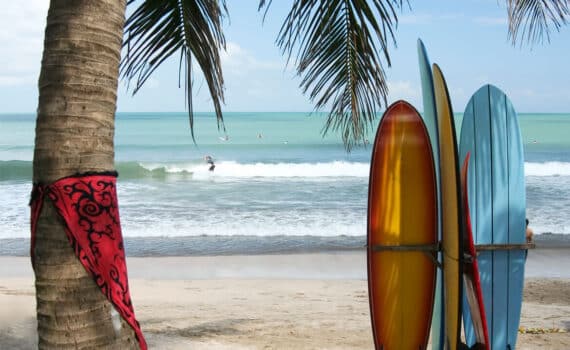The East Coast of the United States offers a diverse range of surfing opportunities, from the chilly waters of New England to the warm, tropical breaks of Florida. While not as renowned as the West Coast, the Eastern Seaboard has gained a reputation for its consistent swells, unique surf culture, and passionate community of wave riders.
Stretching from Maine to Florida, the East Coast encompasses a vast geographic area, with each region boasting its own distinct surfing characteristics. The rugged coastline of New England, with its rocky beaches and powerful waves, attracts hardy surfers seeking challenging conditions. As you move south, the Mid-Atlantic states like New Jersey and North Carolina offer a mix of beach breaks and point breaks, catering to surfers of all skill levels.
Further south, the warm waters of Florida and the Gulf Coast provide a tropical surfing paradise, with consistent swells and a vibrant surf scene. From the legendary breaks of the Outer Banks to the mellow waves of the Florida Keys, the East Coast offers a diverse array of surf spots to explore.
Despite its reputation as a lesser-known surfing destination, the East Coast has a thriving surf culture that is deeply rooted in local communities. Surf shops, competitions, and festivals dot the coastline, celebrating the region’s rich surfing heritage and fostering a strong sense of camaraderie among wave riders. Whether you’re a seasoned pro or a beginner just catching your first wave, the East Coast surfing experience is one that is sure to leave a lasting impression.
Wave Conditions
The wave conditions along the East Coast of the United States can vary greatly depending on the region and time of year. In general, the East Coast experiences smaller and more inconsistent waves compared to other renowned surf destinations around the world. However, certain areas can offer excellent surf when the conditions align.
The typical wave heights on the East Coast range from 2 to 6 feet, with the occasional larger swell bringing waves up to 8 or 10 feet during peak seasons. The surf breaks tend to be beach breaks, with some point breaks and reef breaks scattered along the coastline.
The seasonality of swell plays a crucial role in determining the quality of surf on the East Coast. During the fall and winter months, powerful storms and hurricanes in the Atlantic Ocean can generate large swells that travel towards the East Coast, delivering some of the best surf conditions of the year. The spring and summer months, on the other hand, are generally characterized by smaller, more inconsistent waves, with the occasional tropical storm or hurricane providing a boost in swell.
Weather Patterns
The East Coast is influenced by various weather systems that can create ideal or challenging surfing conditions. During hurricane season, from June to November, the region is susceptible to powerful storms originating in the Atlantic Ocean. These hurricanes can generate massive swells that travel up the coastline, offering incredible surfing opportunities. However, the accompanying high winds and dangerous conditions make it essential to exercise caution and heed all weather advisories.
Nor’easters, intense low-pressure systems that form along the East Coast, are another significant weather phenomenon. These storms can bring heavy rain, strong winds, and substantial wave action, making for epic surf sessions when the conditions align correctly. Experienced surfers often chase these swells, but the risk of rough and unpredictable conditions demands a high level of skill and preparation.
Wind patterns play a crucial role in shaping the surf on the East Coast. Offshore winds, blowing from the land towards the ocean, tend to create clean, well-formed waves ideal for surfing. In contrast, onshore winds can make the waves choppy and challenging to ride. Local wind patterns can vary significantly depending on the region, with some areas benefiting from consistent offshore breezes while others struggle with predominant onshore winds.
Understanding and closely monitoring weather patterns is essential for East Coast surfers. Staying informed about incoming storms, wind directions, and swell forecasts can help identify the best times and locations for surfing. Experienced surfers often plan their sessions around favorable weather windows, maximizing their chances of catching epic waves while minimizing risks.
Surfing Hotspots
The East Coast of the United States offers a diverse range of surfing hotspots, each with its unique wave conditions, surf culture, and local flavor. From the rugged shores of New England to the tropical paradise of Florida, there’s something for every surfer.
Northeast Region
The Northeast region, including states like Maine, New Hampshire, Massachusetts, Rhode Island, and New Jersey, is known for its powerful beach breaks and occasional point breaks. Here are some top spots:
- Ogunquit Beach, Maine: A classic New England beach break with consistent waves, especially during hurricane season.
- Narragansett Beach, Rhode Island: Famous for its powerful waves and vibrant surf community.
- Long Beach Island, New Jersey: A long stretch of beach with various peaks and sandbars, suitable for all levels.
Mid-Atlantic Region
The Mid-Atlantic region, encompassing states like Delaware, Maryland, Virginia, and North Carolina, offers a mix of beach breaks, point breaks, and occasional reef breaks.
- Outer Banks, North Carolina: A surfer’s paradise with world-class waves, including the legendary Jockeys Ridge.
- Virginia Beach, Virginia: A popular spot with several beach breaks and a lively surf scene.
- Ocean City, Maryland: Known for its consistent beach breaks and family-friendly atmosphere.
Florida
Florida is a surfing mecca, boasting warm waters, consistent waves, and a vibrant surf culture. Some of the top spots include:
- New Smyrna Beach: Often referred to as the “Surf Capital of the East Coast,” with excellent beach breaks and a thriving surf community.
- Cocoa Beach: Home to the iconic Cocoa Beach Pier and numerous beach breaks along the Space Coast.
- Sebastian Inlet: A world-class spot featuring a powerful inlet break and a lively surf town.
No matter where you go on the East Coast, you’re sure to find a surf spot that suits your skill level and preferences, from mellow beach breaks to challenging point breaks.
Water Temperature
The water temperature along the East Coast varies significantly depending on the region and season. In the Northeast, including locations like New Jersey, New York, and New England, the water can be quite chilly, ranging from the low 40s°F (5-10°C) in the winter to the mid 60s°F (18-20°C) in the summer months. Surfers in these areas typically wear 4/3 millimeter wetsuits or even 5/4 millimeter hooded suits during the colder seasons to combat the icy waters and air temperatures.
As you move further south to the Mid-Atlantic region, encompassing areas like Virginia, North Carolina, and parts of Florida, the water warms up considerably. Temperatures can reach the low 80s°F (27-29°C) during the summer, making it comfortable for surfing in just boardshorts or a lightweight spring suit. However, even in these warmer locales, a 3/2 millimeter full suit is recommended for winter surfing when temperatures dip into the 50s°F (10-15°C).
The Florida Keys and Southeast Florida offer the warmest waters along the East Coast, with temperatures hovering around 80°F (27°C) for much of the year. This tropical climate allows for year-round surfing in just trunks or a rash guard. However, even in these balmy conditions, many surfers still opt for a lightweight vest or shorty wetsuit for sun protection and warmth during windy days or cooler spells.
In general, the spring and fall seasons tend to be the most comfortable for surfing without excessive rubber, while winter and summer mark the extremes in terms of wetsuit requirements. Paying close attention to water temperature forecasts and adjusting your wetsuit accordingly can greatly enhance your comfort and performance in the lineup.
Crowds and Localism
The popularity of surfing along the East Coast has led to crowded lineups at many breaks, especially during peak seasons and optimal conditions. While crowds can create a lively and vibrant surf scene, they also raise concerns about localism and wave territoriality. Localism, the protective attitude of resident surfers towards their home breaks, can manifest in various ways, from intense stares and verbal confrontations to physical intimidation or even violence in extreme cases.
Respecting the local surf etiquette and customs is crucial for visiting surfers. Understanding the lineup hierarchy, taking appropriate turns, and displaying consideration for others in the water can go a long way in avoiding conflicts. Beginner surfers should exercise caution at advanced breaks and consider seeking out more suitable locations to hone their skills without disrupting the flow of the lineup.
Crowd management is an ongoing challenge for many East Coast surf spots, with some areas implementing permit systems, time limits, or designated zones to alleviate congestion. Surfers are encouraged to be patient, respectful, and adaptable, as crowding can lead to a less enjoyable and potentially dangerous experience for everyone involved.
Surf Culture
The East Coast of the United States has a rich and vibrant surf culture that has been shaped by the unique conditions and communities found along its shores. From the bustling surf towns of Florida to the quaint seaside villages of New England, the region is home to a diverse array of surf shops, brands, and events that cater to the needs and passions of surfers.
One of the most notable aspects of the East Coast surf culture is the thriving surf towns that have sprung up along the coastline. These towns, such as Cocoa Beach in Florida, Outer Banks in North Carolina, and Montauk in New York, have become hubs for surfers and surf enthusiasts alike. They boast a lively atmosphere, with surf shops, cafes, and bars catering to the surf community, and a laid-back, beach-centric lifestyle that attracts visitors from far and wide.
The surf shops in these towns are more than just retail outlets; they serve as gathering places for surfers to exchange stories, share tips, and forge lasting friendships. Many of these shops are run by local surfers who have a deep understanding of the local conditions and can provide invaluable advice on everything from board selection to wave forecasting.
In addition to the surf shops, the East Coast is also home to several iconic surf brands that have gained national and international recognition. Companies like Billabong, Quiksilver, and Roxy, which have their roots in the West Coast surf scene, have established a strong presence on the East Coast, catering to the region’s growing surf community.
Surf competitions are another integral part of the East Coast surf culture. Events like the East Coast Surfing Championships, held annually in Virginia Beach, and the Vans Surf Open, hosted in Huntington Beach, New York, attract top surfers from around the world and provide a platform for local talent to showcase their skills.
Beyond the competitions, the surf culture on the East Coast also manifests itself in various forms of art, music, and literature. Surf-inspired art galleries, live music venues, and surf-themed literature festivals celebrate the unique lifestyle and ethos of the surf community, further enriching the cultural tapestry of the region.
Environmental Factors
The east coast’s diverse marine environments present both opportunities and challenges for surfers. Water quality can vary considerably, with some areas impacted by urban runoff, sewage overflows, and industrial pollution. Surfers should stay informed about local water quality advisories and avoid surfing after heavy rainfall, which can increase contamination levels.
Beach erosion is another concern, particularly in areas prone to strong storms and rising sea levels. Eroding beaches can create hazardous conditions, such as steep drop-offs and exposed rocks or debris. Surfers should exercise caution and avoid areas with significant erosion.
Marine life encounters are also a possibility on the east coast. While shark sightings are relatively rare, they do occur, and surfers should be aware of the potential risk. Stingrays, jellyfish, and other marine creatures can also pose a threat, particularly in certain regions and during specific seasons. Surfers should familiarize themselves with local marine life and take appropriate precautions.
Travel and Access
Getting to remote surf spots along the East Coast can be challenging, as many are situated far from major cities and airports. Renting a car or camper van is often necessary to reach these more isolated breaks. Surf camps and lodges catering to traveling surfers have popped up in popular areas, offering accommodation packages and local knowledge.
In certain locations, permits or passes may be required to access beaches or parks with good surf. Paying close attention to local regulations is advised. Some remote spots on private land or indigenous territory have strict access rules that must be respected. With proper planning and an adventurous spirit, scoring uncrowded waves in pristine settings becomes achievable.
Safety Considerations for East Coast Surfing
While surfing can be an exhilarating experience, it’s crucial to prioritize safety when hitting the waves on the East Coast. One of the primary hazards is rip currents, which are powerful, channeled currents that flow away from the shore. These currents can quickly sweep even the strongest swimmers out to sea. To escape a rip current, it’s recommended to remain calm, avoid fighting against the current directly, and swim parallel to the shoreline until you’re out of its pull, then make your way back to land.
Another potential danger is marine life. Certain areas along the East Coast are home to sharks, jellyfish, stingrays, and other marine creatures that can pose a threat to surfers. It’s essential to research the local marine life and take necessary precautions, such as avoiding murky water, staying away from areas known for shark activity, and shuffling your feet when entering the water to avoid stepping on stingrays.
Surf etiquette is also an important aspect of safety. Overcrowded lineups can lead to collisions and altercations, so it’s crucial to respect the rules of the lineup, avoid dropping in on others, and be aware of your surroundings at all times. Additionally, surfing during hazardous conditions, such as high winds, large swells, or after heavy rainfall (which can increase the risk of rip currents and pollution), should be avoided.
By being aware of these potential hazards and taking the necessary precautions, surfers can enjoy surfing the East Coast while minimizing risks to their safety.


